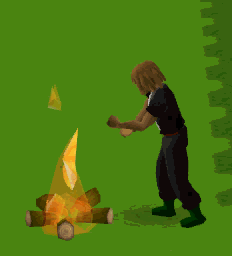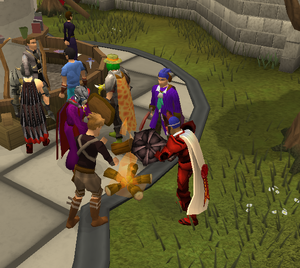Bonfire
- This article is about firemaking method. For the bonfire involved in fighting Sköll, see Bonfire (2012 Winter Event).


Bonfires are one of the best methods for training firemaking released with an update on 10 May 2012. It introduces the feature of being able to add more logs directly onto a fire.
This training method is available to members and non-members. This activity also gives strange rocks, and spin tickets.
Other players may add logs onto your fire, and everyone contributing will receive bonus firemaking experience for the logs added. Also, the player receives a health boost depending on his/her firemaking level, and the logs used. Cooking on the fire will also provide boosts to cooking experience.
Bonfires may last different lengths based on the type of logs used to create it. Depending on the type of log that was used to start the fire, the colour of the logs will be different. Bonfires will die away after a certain amount of time, even if you keep feeding logs to it.
Different logs may be added to a bonfire at different speeds. See the table near the bottom of this page for burning times for various logs.
Logs can be added to a bonfire in three ways:
- Right click on the log and "Use" it on an already lit fire.
- Right-click on an already lit fire and select "Add-logs Fire".
- Open the "Craft" menu while standing near a fire and select "Add to bonfire".
Just like when you chop down a tree, your player will keep adding logs to the fire without you needing to click constantly. It is possible for players with a low firemaking level to apparently burn their hand and is unable to throw a log into a bonfire occasionally.
The most popular place for training Firemaking with bonfires is the Lumbridge castle cellar, where on Firemaking friends chat worlds (which are usually advertised on the official forums) a fire is often lit so that players may add logs into it without moving away from the bank chest there. Other popular places for bonfires are Skill Total (1500)worlds, where there is always a bonfire lit near each of the four Grand Exchange booths, and the Castle Wars bank chest; a full bonfire is almost always available there in any (members) world. World 100 in the Lumbridge Castle cellar is always filled with multiple players, and is a very easy way to train Firemaking due to the one-click bank option. It is the unofficial bonfire world, and there are, on average, well over 100 players at any given time, including at Castle Wars and the Shantay Pass. There are also at least 5 people in nearly every world at the Southwest stall in the Grand Exchange.
Experience
This section is a stub. Please help expand it.
Using logs with a bonfire instead of starting a new fire grants the following experience values. These values may change depending on your firemaking level. These also may be increased with the firemaking boosts detailed below. Also, higher level logs may be added to a bonfire more quickly (see Time & Speed table below) to increase experience gain speed.
| Log type | Experience | ||||
|---|---|---|---|---|---|
| Regular | Bonfire (1 Player) | Bonfire (5+ Players) | Bonfire (5+ Players) with:
| ||
| Regular | 40 | 50 | 52.5 | 58 | |
| Oak | 60 | 85 | 89.25 | 96 | |
| Willow | 90 | 105 | 110.25 | 115.8 | |
| Teak (m) | 105 | 120 | 126 | 132.2 | |
| Maple* | 135 | 135 to 175 | 140.4 to 182 | 147.4 to 191.1 | |
| Mahogany (m) | 157.5 | 180 | 189 | 198.5 | |
| Arctic Pine (m) | 125 | 130 | 136.5 | 143.3 | |
| Eucalyptus (m) | 193 | 195 | 204.75 | 215 | |
| Yew | 202.5 | 260 | 270.25 | 283.8 | |
| Magic (m) | 303.8 | 309.5 | 325 | 341.2 | |
- The experience rate of Maple logs are dependent on the player's Firemaking level. The table shows "#1 to #2", #1 being the exp gained at level 45 firemaking, #2 being the exp gained at level 99 firemaking.
Boosts
Firemaking boost

Adding logs into a bonfire that is being used by more players grants a Firemaking experience boost compared to the basic experience for adding logs to one's own bonfires.
| Players | XP Boost |
|---|---|
| 2 | 1% |
| 3 | 2% |
| 4 | 3% |
| 5+ |
|
A significant boost is also obtained through utilising bonfires based on the player's firemaking level. For every firemaking level, the experience granted is boosted by a small, constant percentage. This effect is immediately noticeable when levelling up during training, as the maximum experience gained through burning the same logs instantly increases by 1 on many occasions.
This boost can be further increased by the aid of other items boosting Firemaking experience, like: the Ring of Fire, Flame gloves, the Dwarven Army Axe, the Barbarian Assault Penance horn and the Clan ring, though Summoning familiars do not add to the boost.
Life point boosts
After adding 5 logs in a row of the same type to a bonfire, you will be given a boost to your maximum life points (but not the Constitution skill). The amount of life points boosted depends on a player's Firemaking level; the length of time the boost is active for depends on the type of logs used on an existing bonfire, regardless of the type of log used to start it. The effect stacks with other life point boosts, such as those from Saradomin brews. Also, the health boost carries into any dungeons you enter after receiving it, and even if you die whilst dungeoneering, you still retain this health boost.
The timer will continue running even when logged out.
| Firemaking Level | Life Point Boost |
|---|---|
| 1-9 | 1% |
| 10-19 | 2% |
| 20-29 | 3% |
| 30-39 | 4% |
| 40-49 | 5% |
| 50-59 | 6% |
| 60-69 | 7% |
| 70-79 | 8% |
| 80-89 | 9% |
| 90-99 | 10% |
| Log type | Boost Time |
|---|---|
| Normal & Achey (m) | 6 minutes |
| Oak | 12 minutes |
| Willow* | 18 minutes |
| Teak (m) | 24 minutes |
| Arctic pine (m) | 30 minutes |
| Maple | 36 minutes |
| Mahogany logs (m) | 42 minutes |
| Eucalyptus logs (m) | 48 minutes |
| Yew | 54 minutes |
| Magic (m)* & Blisterwood (m) | 60 minutes |
* Cursed versions can also be added.
Cooking boost
When cooking on a bonfire, you will receive a 10% boost in Cooking experience. This stacks with other boosts and bonuses to Cooking experience, like the dwarven army axe and clan ring. Note: If a bonfire goes out while a player is cooking food, he will receive regular experience rather than boosted experience for that piece of food if it is successfully cooked.
Burning Time & Speed
Each type of log has a fixed burning timer; the better the log, the longer a fire will burn and (up to a point) the faster logs can be added to a bonfire. A log with a longer burning time enables players to cook on the fire or add additional logs to the fire for a longer time without needing to start another fire. Therefore, it is beneficial to use better logs when lighting bonfires. Examining a fire reveals the type of log burned. (m) = Members Only.
| Log Type |
Approximate Burn Duration* |
Approximate Burn Speed (25 logs)** |
| Regular | 2 minutes 00 seconds (120 seconds) | 2 minutes 42 seconds (162 seconds) |
| Oak | 2 minutes 20 seconds (140 seconds) | 1 minutes 45 seconds (105 seconds) |
| Willow | 2 minutes 50 seconds (170 seconds) | 1 minutes 45 seconds (105 seconds) |
| Teak (m) | 3 minutes 10 seconds (190 seconds) | 1 minute 30 seconds (90 seconds) |
| Maple | 3 minutes 30 seconds (210 seconds) | 1 minute 30 seconds (90 seconds) |
| Arctic (m) | 3 minutes 20 seconds (200 seconds) | 1 minute 30 seconds (90 seconds) |
| Mahogany (m) | 4 minutes 00 seconds (240 seconds) | 1 minute 30 seconds (90 seconds) |
| Yew | 5 minutes 00 seconds (300 seconds) | 1 minute 30 seconds (90 seconds) |
| Magic (m) | 5 minutes 30 seconds (330 seconds) | 1 minute 30 seconds (90 seconds) |
| Blisterwood (m) | 5 minutes 30 seconds (330 seconds) |
1 minute 30 seconds (90 seconds) |
- This is the approximate duration a single log will burn, giving time to add additional logs to a bonfire, or to cook over the fire. **This is the approximate time it takes to use 25 logs out of inventory on a bonfire, averaged over 4 attempts and rounded to the nearest second. Base fire was Maple for purposes of testing, but spot testing other types shows that the base fire apparently makes no difference in overall speed. Character used for testing was 99 Firemaking, it is unknown at this time if level affects speed.
Fire spirit

Training Firemaking in this way also gives the possibility of finding strange fire spirits who'll reward you for freeing them from their wooden prisons.
The chance of freeing a fire spirit is not based on the type of logs used. It was confirmed that every log holds a 1/100 chance to release a fire spirit. Fire spirits last for one minute before disappearing. It is possible for multiple Fire Spirits to be present concurrently.
Upon freeing them, the player must click the spirit. The spirit gives rewards, usually some common runes, coins, ore (noted), gems, ashes and various charms.
Fire spirits are an excellent way for low leveled players to get charms for summoning. Getting charms this way is slower, but you will not have to fight high leveled enemies to get charms using this method.
Gallery
-
An advertisement for Bonfires.
Trivia
- There was a glitch where the fire spirit gave out member items to non-members, such as charms. This, however, was fixed a few hours after release.
- Bonfires were introduced on the day of Lag Baomer, a Jewish holiday which some celebrate by having a party around a bonfire.
- Using a coloured log (gnomish firelighters) on any bonfire will change the colour of the flame, corresponding to the colour of the log.
- There is a possibility for two or more fire spirits to appear at once.
- Players find life point boosts from bonfires to be very helpful when dungeoneering: if the player enters a dungeon after receiving the boost, he or she retains the boosted life points cap.
- Magpies are a useful familiar to use whilst lighting bonfires, as they easily gather around 20-30k per spirit pouch from gems and jewellery, resulting in an easy way to make money while playing away from the keyboard.
- There is a graphical glitch where if the player is holding a bow and warms their hands on the fire, the bow will remain visible in the player's hand. Same thing happens with the Tome of Frost.